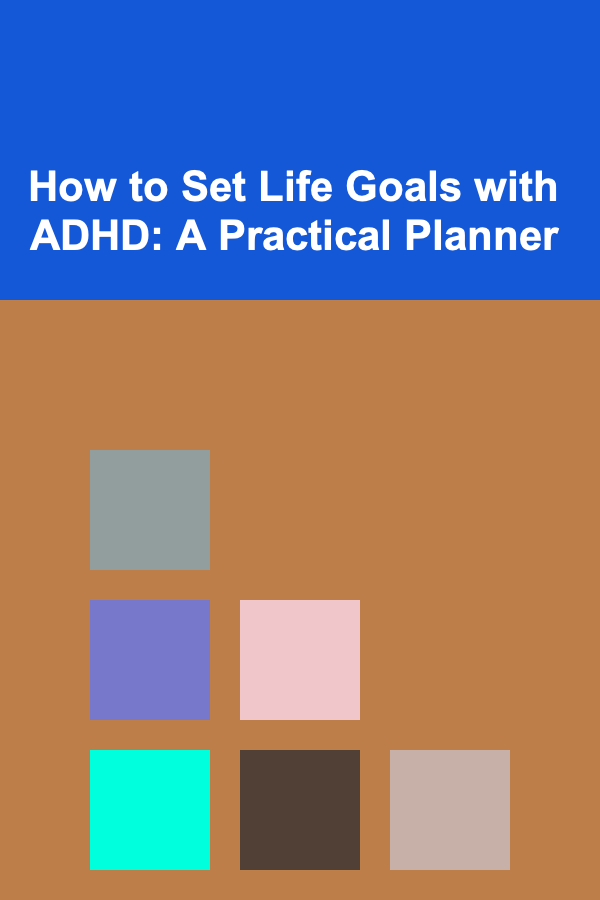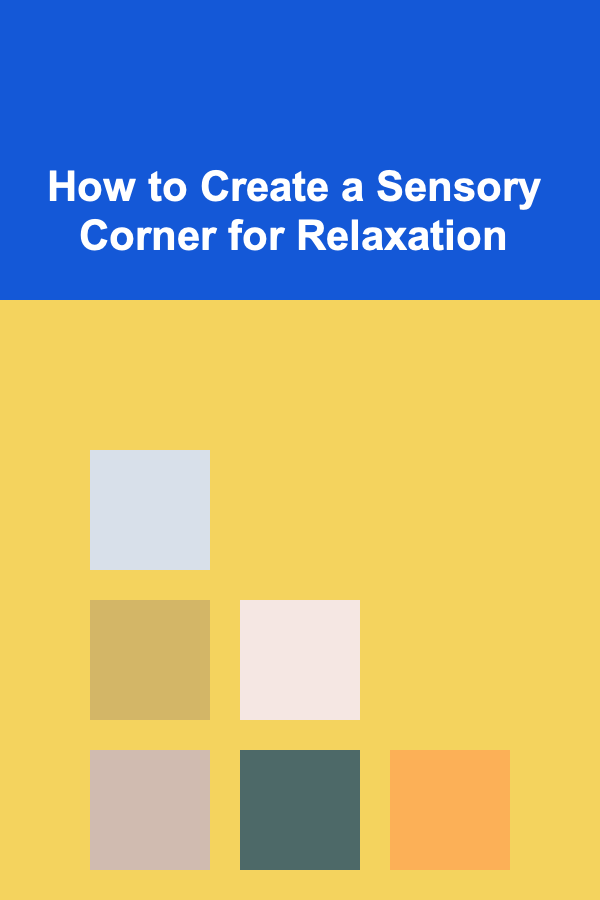
How to Set Life Goals with ADHD: A Practical Planner
ebook include PDF & Audio bundle (Micro Guide)
$12.99$9.99
Limited Time Offer! Order within the next:

Setting life goals is an essential part of personal growth, but for individuals with Attention Deficit Hyperactivity Disorder (ADHD), this process can feel particularly challenging. The symptoms of ADHD---such as distractibility, impulsivity, and difficulties with organization---can make it harder to focus on long-term goals, create structured plans, and follow through with tasks. However, with the right strategies, individuals with ADHD can set meaningful life goals and achieve them. In this article, we will discuss how to effectively set life goals while managing ADHD, focusing on creating a practical, achievable planner that aligns with the unique needs of people with ADHD.
Understanding ADHD and Its Impact on Goal Setting
ADHD affects millions of individuals worldwide, with its symptoms often causing significant challenges in many areas of life, including work, education, and personal relationships. One of the core difficulties people with ADHD face is the inability to sustain attention on tasks, particularly when they are long-term or abstract. This challenge often leads to difficulties in setting clear and realistic life goals.
In addition to inattention, individuals with ADHD may also struggle with:
- Impulsivity: Making decisions quickly without fully considering the consequences.
- Hyperactivity: Constantly needing to move or act, making it challenging to remain still and concentrate for long periods.
- Difficulty with Time Management: A poor sense of time often leads to procrastination or underestimating the amount of time it takes to accomplish tasks.
Despite these challenges, setting life goals is still possible with the right approach. The key is to break down large goals into manageable chunks, stay focused on the present moment, and utilize ADHD-friendly techniques that play to one's strengths.
Step 1: Clarify Your Long-Term Vision
Before setting specific life goals, it is important to take the time to clarify your long-term vision. This is the overall direction you want to take in life. Understanding your core values and what is truly important to you is the first step in building a foundation for goal setting.
- Reflection: Start by reflecting on the areas of your life that matter most to you---career, health, relationships, personal growth, and hobbies. What would your ideal life look like in five or ten years? Be specific about the kind of person you want to be and the experiences you hope to have.
- Big Picture Thinking: ADHD can make it hard to focus on abstract goals, so it's important to focus on tangible outcomes that resonate with you. For example, instead of saying, "I want to be successful in my career," break it down into something more concrete, such as "I want to achieve a managerial position in my current field within the next five years."
- Create a Vision Board: Visual aids can be particularly helpful for individuals with ADHD. Consider creating a vision board that visually represents your long-term goals and desired life outcomes. This can serve as a constant reminder of your aspirations and keep you motivated.
Step 2: Break Down Long-Term Goals into Smaller, Manageable Steps
One of the most common struggles individuals with ADHD face is breaking down large, overwhelming tasks into smaller, manageable chunks. This is especially true when setting long-term life goals.
- Chunking: Break down your long-term goals into smaller, specific objectives. For instance, if your long-term goal is to run a marathon, you could break it down into sub-goals like "train for 10 minutes a day," "run a 5k," and "join a running group." Each of these sub-goals is tangible and achievable, making it easier to stay focused and motivated.
- Set Milestones: Define short-term milestones that will help you measure progress. For example, if your goal is to get a degree, set milestones such as "complete application," "finish first semester," and "graduate." These smaller steps make the process seem less daunting and more achievable.
- Create Action Plans: Once you've broken down your goals into smaller chunks, create a detailed action plan. What are the specific tasks you need to complete each week or month to achieve your goal? Use a calendar or planner to assign deadlines to each task, making it easier to track your progress and stay accountable.
Step 3: Use ADHD-Friendly Tools and Techniques
There are several tools and techniques that individuals with ADHD can use to set and track their goals more effectively. These ADHD-friendly tools help maintain focus, boost productivity, and reduce the risk of distractions.
Time Management Tools
People with ADHD often struggle with managing time, which can lead to procrastination or feeling overwhelmed. The following tools can help:
- Timers and Alarms: Use timers to break your work into short, focused intervals. The Pomodoro technique, which involves working for 25 minutes and then taking a 5-minute break, is particularly effective. Set alarms or reminders to keep yourself on track.
- Digital Calendars: Use digital calendars like Google Calendar or Apple Calendar to set reminders for tasks and deadlines. Digital tools are especially helpful because they send notifications, which can help keep you on track.
- Task Management Apps: Apps like Trello, Todoist, or Notion are useful for organizing tasks and goals. These apps allow you to create to-do lists, set priorities, and track progress visually. This can help individuals with ADHD stay organized and avoid feeling overwhelmed by large tasks.
Visual Reminders
Visual reminders can serve as a constant prompt to help keep your goals in front of your mind.
- Post-It Notes: Place Post-It notes in prominent places to remind yourself of important tasks. These can be color-coded to indicate priority or urgency.
- Whiteboards: A whiteboard in your home or office can be used to write down your goals and track your progress. It can be satisfying to wipe off completed tasks, giving you a sense of accomplishment.
Accountability Partners
Having someone to hold you accountable can be a game-changer when it comes to achieving goals.
- Set Regular Check-Ins: Share your goals with a friend, family member, or mentor who can check in with you regularly to see how you're doing. Accountability partners help you stay on track and remind you of your objectives when your focus wavers.
Step 4: Focus on One Goal at a Time
ADHD often leads to difficulty focusing on multiple tasks simultaneously, making it challenging to juggle several life goals at once. To avoid feeling overwhelmed, it's helpful to focus on one goal at a time.
- Prioritize: Start by deciding which goal is most important to you at the moment. If you're unsure, ask yourself which goal will have the most significant impact on your life right now. Once you've prioritized your goal, give it your full attention.
- Limit Distractions: When working on a goal, create an environment that minimizes distractions. Turn off unnecessary notifications, put your phone on silent, and work in a quiet space.
- Celebrate Small Wins: Recognize and celebrate your progress, even the smallest achievements. This will keep you motivated and focused on continuing to work toward your goal.
Step 5: Build Routines and Habits
Creating routines and habits around your goals can help streamline the process and reduce the cognitive load involved in setting and achieving goals.
- Morning or Evening Routines: Establish a daily routine that includes time for working on your goals. For example, you might dedicate the first 30 minutes of your day to working on a long-term project or set aside time each evening to review your progress and plan for the next day.
- Habit Stacking: This technique involves pairing a new habit with an existing one. For example, after brushing your teeth in the morning, you could immediately work on a goal-related task, such as reviewing your to-do list or reading a chapter of a book related to your goal.
- Consistency Over Perfection: ADHD can make it hard to maintain perfect habits, but consistency is key. Focus on showing up regularly, even if it's for a short amount of time, rather than trying to achieve perfection.
Step 6: Be Flexible and Adapt Your Plan
Life doesn't always go according to plan, and people with ADHD may face additional challenges along the way. Being flexible and adaptable in your approach to goal setting is essential.
- Accept Setbacks: Understand that setbacks are a natural part of the process. When you face difficulties, don't be too hard on yourself. Instead, reassess your approach and adjust your plan as needed.
- Review and Adjust Regularly: Regularly review your progress and make adjustments to your plan. If you find that certain techniques aren't working for you, explore alternatives and be willing to change your approach.
Step 7: Take Care of Your Mental and Physical Health
Finally, managing your mental and physical health is essential for goal setting. ADHD can be exhausting, and neglecting your health can negatively impact your ability to focus and stay motivated.
- Exercise: Regular physical activity helps improve focus, reduce anxiety, and manage stress, all of which can contribute to better goal-setting outcomes.
- Sleep and Nutrition: Make sure to get enough sleep and maintain a balanced diet. Proper rest and nutrition play a crucial role in brain function and overall well-being.
- Mindfulness and Relaxation: Practice mindfulness, meditation, or deep breathing exercises to manage stress and improve your ability to focus.
Conclusion
Setting and achieving life goals with ADHD may require a different approach, but it is entirely possible. By breaking down long-term goals into manageable tasks, using ADHD-friendly tools and techniques, and staying focused on one goal at a time, individuals with ADHD can achieve their desired outcomes. Building routines, staying flexible, and prioritizing mental and physical health will further enhance the likelihood of success. With the right mindset and strategies, ADHD doesn't have to be a barrier to achieving life's goals---it can be a stepping stone to even greater personal growth.
Reading More From Our Other Websites
- [Home Staging 101] How to Home Stage a Beach House for the Ultimate Coastal Vibe
- [Skydiving Tip 101] From First Jump to Freefall Mastery: A Beginner's Guide to Skydiving Training
- [Scrapbooking Tip 101] Design Hacks: How to Turn Everyday Photos into Stunning Digital Pages
- [Personal Care Tips 101] How to Combine Face Serum with Other Skincare Products
- [Home Pet Care 101] How to Deal with Pet Hair on Furniture and Clothes
- [Organization Tip 101] How to Evaluate the Success of Your Charity Initiatives
- [Home Family Activity 101] How to Stargaze from Your Backyard for a Family Fun Night
- [Home Pet Care 101] Dealing with a Picky Eater (Dog or Cat)
- [Home Family Activity 101] How to Start a Family Baking Challenge at Home
- [Home Cleaning 101] How to Organize Your Cleaning Supplies Effectively

Eco-Friendly and Affordable Alternative Transportation Options You Need to Know
Read More
How to Create a Sensory Corner for Relaxation
Read More
How to Maximize Space in Small Home Renovations
Read More
How to Set Up a Family-Friendly Bathroom Organization System
Read More
How To Improve Your Problem-Solving Abilities
Read More
10 Tips for Designing Food Product Packaging
Read MoreOther Products

Eco-Friendly and Affordable Alternative Transportation Options You Need to Know
Read More
How to Create a Sensory Corner for Relaxation
Read More
How to Maximize Space in Small Home Renovations
Read More
How to Set Up a Family-Friendly Bathroom Organization System
Read More
How To Improve Your Problem-Solving Abilities
Read More